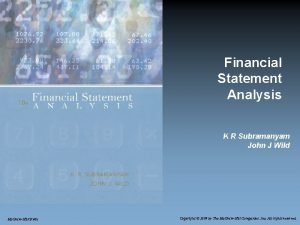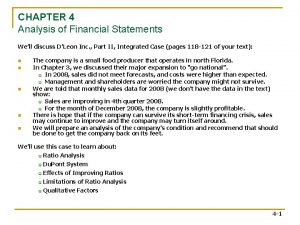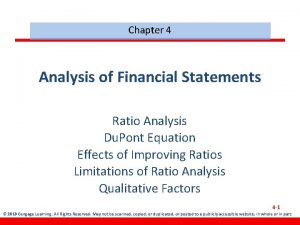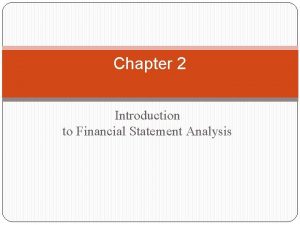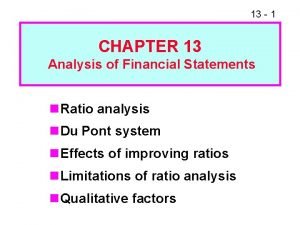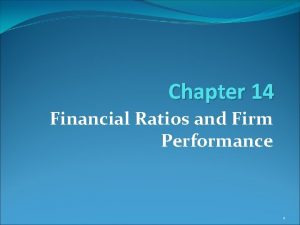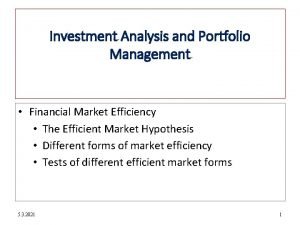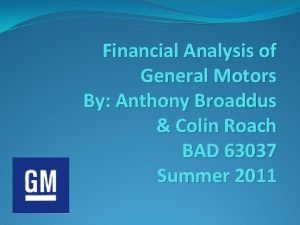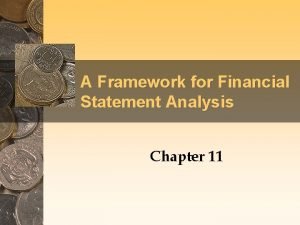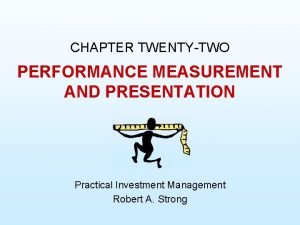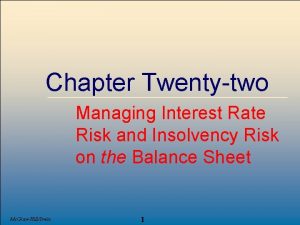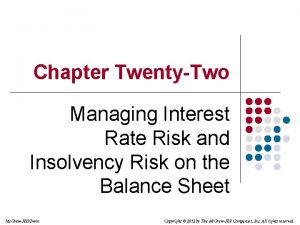CHAPTER TWENTYTWO FINANCIAL ANALYSIS FINANCIAL ANALYSIS n WHAT























- Slides: 23

CHAPTER TWENTY-TWO FINANCIAL ANALYSIS

FINANCIAL ANALYSIS n WHAT IS FINANCIAL ANALYSIS? • DEFINITION: the activity of providing inputs to the portfolio management process

FINANCIAL ANALYSIS n PROFESSIONAL FINANCIAL ANALYSIS ORGANIZATIONS • THE ASSOCIATION OF INVESTMENT MANAGEMENT AND RESEARCH (AIMR) 3 acts as an advocate for the financial analyst profession 3 it host conferencing and workshops – designed to enhance the knowledge base of the memberships 3 it also publishes the Financial Analysts Journal

FINANCIAL ANALYSIS n PROFESSIONAL FINANCIAL ANALYSIS ORGANIZATIONS • THE ASSOCIATION OF INVESTMENT MANAGEMENT AND RESEARCH (AIMR) 3 Chartered Financial Analysts – – – a subdivision of AIMR is a program to establish a hurdle that creates a common set of investment knowledge for a select membership it also promotes an ethical standard for the various types of investment professionals

FINANCIAL ANALYSIS n REASONS FOR FINANCIAL ANALYSIS • TWO PRIMARY REASONS 3 to determine certain securities characteristics 3 to attempt to identify mispriced securities

FINANCIAL ANALYSIS n REASON #1: DETERMNING SECURITY CHARACTERISTICS • estimate future sensitivity to major factors • estimate dividend yield

FINANCIAL ANALYSIS n REASON #2: ATTEMPTING TO IDENTIFY MISPRICED SECURITIES • use fundamental analysis • approaches 3 valuation determines the intrinsic value compared to the current market value 3 estimate key financial variables such as – – EPS next year income growth next year

TECHNICAL ANAYSIS n DEFINITION: a form of security analysis that attempts to forecast price changes based on historical price and volume trends

TECHNICAL ANAYSIS n Two Groups of Strategies Used: 1. Momentum and Contrarian Strategies 2. Moving Average and Trading Range Breakout Strategies

TECHNICAL ANAYSIS 1. Momentum and Contrarian Strategies • METHDOLOGY: 3 examine the returns over a time period just ended to identify – – momentum investors who seek out stocks recently rising in price for purchase; falling for sale contrarians who follow the opposite strategy of most investors • contrarians base their strategy on the overreation theory

TECHNICAL ANAYSIS 2. Moving Average and Trading Range Breakout Strategies • MOVING AVERAGE STRATEGY: 3 calculate a moving average over the last 200 days of closing prices 3 divdied today’s closing price into the moving average (SHORT-TO-LONG RATIO) 3 if short-to-long ratio is greater than 1, buy 3 if ratio is less than 1, sell

TECHNICAL ANAYSIS n 2. Moving Average and Trading Range Breakout Strategies • TRADING RANGE BREAKOUT STRATEGY: 3 high and low prices for past 200 trading days are identified 3 if today’s close is greater than the high = buy! 3 if today’s close is less than the low = sell!

FUNDAMENTAL ANALYSIS n TOP-DOWN V. BOTTOM UP • TOP-DOWN APPROACH 3 attempts to forecast in the following order 1. economic activity 2. industry performance 3. firm’s performance

FUNDAMENTAL ANALYSIS n TOP-DOWN V. BOTTOM UP • BOTTOM-UP APPROACH: 3 attempts to estimate order: 1. The firm 2. The Industry 3. The economy prospects in the following

FUNDAMENTAL ANALYSIS n FINANCIAL STATMENT ANALYSIS • INTEGRAL PART OF FUNDAMENTAL ANALYSIS 3 it helps the analyst understand a firm’s current condition 3 where it is headed 3 what factors affect it 3 how the factors affect it

FUNDAMENTAL ANALYSIS n FINANCIAL STATMENT ANALYSIS • Review of Accounting Statements 3 includes a study of the three major statements prepared monthly by most accountants: – – – the balance sheet the income statement the statment of cash flows

FUNDAMENTAL ANALYSIS n FINANCIAL STATMENT ANALYSIS • RATIO ANALYSIS 3 DEFINITION: a technique used to examine a company’s financial statements 3 Use of Ratios – – as an absolute standard as a comparative indicator as a trend over time in combination with technical analysis

FUNDAMENTAL ANALYSIS n FINANCIAL STATMENT ANALYSIS • RATIO ANALYSIS 3 Types of Ratios – – internal liquidity operating performance risk analysis growth analysis

FUNDAMENTAL ANALYSIS n internal liquidity ratios: • indicate the ability of the firm to meet future short-term financial obligations • some liquidity ratios: 3 current ratio 3 quick ratio 3 cash ratio 3 receivables turnover

FUNDAMENTAL ANALYSIS n operating performance ratios: • indicate how well the management is operating the business • some examples: 3 total asset turnover 3 net fixed asset turnover 3 equity turnover

FUNDAMENTAL ANALYSIS n risk analysis ratios: • indicates the uncertainty of income flows for the total firm and for the individual sources of capital (debt and stock) • some examples: 3 debt to equity ratio 3 long-term debt/total capital ratio

FUNDAMENTAL ANALYSIS n growth analysis ratios: • indicate how fast a firm should grow • it involves analysis using several other ratios 3 net profit margin 3 total asset turnover 3 total assets/equity

END OF CHAPTER 22
 Chapter 14 financial statement analysis solutions
Chapter 14 financial statement analysis solutions Subramanyam financial statement analysis
Subramanyam financial statement analysis Chapter 3 analysis of financial statements
Chapter 3 analysis of financial statements Chapter 14 financial statement analysis solutions
Chapter 14 financial statement analysis solutions Chapter 4 analysis of financial statements
Chapter 4 analysis of financial statements Chapter 4 analysis of financial statements
Chapter 4 analysis of financial statements How to improve current ratio
How to improve current ratio Chapter 2 financial statement analysis solutions
Chapter 2 financial statement analysis solutions Chapter 13 financial statement analysis
Chapter 13 financial statement analysis Analysis of financial statements
Analysis of financial statements Chapter 1 overview of financial statement analysis
Chapter 1 overview of financial statement analysis Chapter 14 financial statement analysis
Chapter 14 financial statement analysis Financial method of motivation
Financial method of motivation Financial investment analysis
Financial investment analysis Limitations of financial statement analysis
Limitations of financial statement analysis Financial analysis of product management
Financial analysis of product management Financial investment analysis
Financial investment analysis Under armour financial ratios
Under armour financial ratios Tq_transmute
Tq_transmute General motors mission statement
General motors mission statement Automated financial analysis
Automated financial analysis Framework for financial analysis
Framework for financial analysis Banking financial statement analysis
Banking financial statement analysis Objectives of financial statement analysis
Objectives of financial statement analysis

